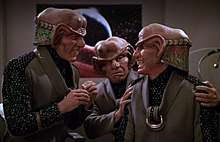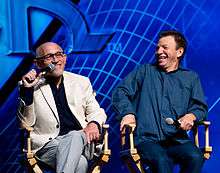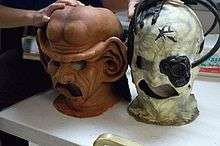Ferengi
The Ferengi (/fəˈrɛŋɡi/) are a fictional extraterrestrial species in the American science fiction franchise Star Trek. They were devised in 1987 for the series Star Trek: The Next Generation before being used in the subsequent series Star Trek: Deep Space Nine, Star Trek: Voyager, and Star Trek: Enterprise.

When launching Star Trek: The Next Generation in 1987, Gene Roddenberry and the show's writers decided to introduce a new alien species to serve as antagonists for the crew of the USS Enterprise-D. The Ferengi first appeared in "The Last Outpost", the show's fourth episode, which was set in the year 2364. The writers decided that the Ferengi ultimately failed to appear sufficiently menacing, instead replacing them with the Romulans and Borg as primary antagonists. Throughout the rest of the series, Ferengi characters were primarily used for comedic effect. When creating Star Trek: Deep Space Nine, the show's writers decided to introduce the Ferengi bartender Quark (Armin Shimerman)—and subsequently his brother Rom (Max Grodénchik) and nephew Nog (Aron Eisenberg)—as recurring characters, again largely using them for comedic purposes. Ferengi characters were subsequently utilised in a single episode of Star Trek: Enterprise and a few times in Star Trek: Voyager.
Deep Space Nine writers have described how they saw the Ferengi as a satirical presentation of 20th century humans. Critics have drawn comparisons between the Ferengi and anti-Semitic stereotypes of Jews.
Name
The name Ferengi was coined based on the Persian term Ferenghi, used throughout Asia (compare older Feringhee), meaning "foreigners" or "Europeans".[1] It is derived from the ethnonym "Frank".
History
Star Trek: The Next Generation
While preparing scripts for the first season of Star Trek: The Next Generation, the idea of the Ferengi was devised by Gene Roddenberry and Herbert Wright.[2] The new alien species initially appeared in the first season's fourth episode, "The Last Outpost", which was based on a story by Richard Krzemien and a teleplay by Wright.[3] In this story, the USS Enterprise-D—whose crew are the main protagonists of the series—makes first contact with the Ferengi while pursuing one of their vessels, which has stolen a T-9 energy converter. Both ships are immobilized over an unknown planet, leading both to send away parties to investigate, where they encounter each other.[4] One of the actors who played a Ferengi in "The Last Outpost", Armin Shimerman, would go on to play a Ferengi again in the later episode "Peak Performance" before being cast as the Ferengi bartender Quark in Star Trek: Deep Space Nine.[2]

The Ferengi outfits designed for "The Last Outpost" featured fur wrap-arounds.[2] As weapons, they were given blue whips that fired energy bolts when cracked; these were subsequently dropped from the series and not used in later depictions of the species.[2] Mike Okuda designed the Ferengi insignia to present the idea of "dog eat dog". It was colored green because of that color's associations with greed, envy, and money.[2] The Ferengi ship featured in the episode was designed by Andy Probert, who used a horseshoe crab on Wright's desk as inspiration, with the model then being constructed by Greg Jein.[2]
The Ferengi were reused for the season's ninth episode, "The Battle", based on a story by Larry Forrester that Wright converted into a teleplay.[5] This episode was first aired in November 1987.[6] In it, a Ferengi called DaiMon Bok gives the Enterprise Captain Jean-Luc Picard (Patrick Stewart) the derelict ship that the latter once captained, the Stargazer. Over the course of the episode, it is revealed that this is part of Bok's plan for vengeance, for he holds Picard responsible for the death of his son many years before.[7] Forrester's first plot outline had featured various scenes aboard the Ferengi spaceship, but these did not make it into the episode.[7] Series writer Rick Berman later noted that because of their "silliness quotient", the Ferengi became "a disappointment as a major adversary".[7]
For the second-season episode "Peak Performance", written by David Kemper and directed by Robert Scheerer, the USS-Enterprise-D is depicted encountering a hostile Ferengi ship while engaging in a practice exercise.[8] The Ferengi uniform was revised for this episode, and new collar pips were added to designate their differing ranks.[9] The season three episode "The Price", which was written by Hannah Louise Shearer, directed by Robert Scheerer, and first aired in November 1989, also included Ferengi characters. In it, two Ferengi delegates compete against their Federation counterparts to gain access to a newly discovered stable wormhole; later in the episode, it is revealed that the wormhole was not really stable and the Ferengi get stuck on the other side of it, in a distant part of the galaxy.[10] "The Price" is the first episode in which a Ferengi starship was referred to as a "marauder".[11]
Star Trek: Deep Space Nine

When the writers were putting together the premise of Star Trek: Deep Space Nine, they decided to introduce a recurring Ferengi character who could inhabit the Deep Space Nine space station which was used as the main setting for the show. The show's co-creator, Michael Piller, later noted that: "It was clear to me that having a Ferengi aboard Deep Space 9 would provide the show with instant humor and built-in conflict with the Federation guy in charge of the station".[12] The show's creators developed the character of Quark, a Ferengi bartender who would, according to Piller, be "a constant thorn in the side of law and order, but who has a sense of humor about it. He'd be someone who could obviously throw lots of story dynamics into play."[12] Piller and the others consciously wanted to play the Quark character off against the station constable, Odo (René Auberjonois); according to Piller, "the idea of Odo and Quark being at loggerheads was there from day one".[12]
The inclusion of Nog as a Starfleet officer prompted discussions on electronic mailing lists devoted to Star Trek. Various commentators suggested that, given how Nog had behaved in previous episodes, it was surprising that Starfleet would take him on. They suggested that this might indicate that Starfleet had some form of affirmative action policy to benefit species not presently represented in Starfleet. Other online commentators argued that this viewpoint was racist, and that Nog would have been accepted as a Starfleet cadet because he was qualified, not because of his racial identity.[13]
Attributes
Biology

The Ferengi were first designed by Andrew Probert and later refined and produced by Michael Westmore.[14]
The most prominent feature in Ferengi design is their large ear lobes, which carry sexual connotations. In both DS9 and TNG, Ferengi experience sexual stimulation when their lobes are rubbed — an act called "oo-mox".[14] Ferengi females allegedly have smaller lobes, but the only female Ferengi characters are Pel and Ishka. Betazoids are incapable of reading Ferengi emotions.[14]
Comparisons with anti-Semitic stereotypes

Various critics have argued that the depiction of the Ferengi and their culture mirrors anti-Semitic stereotypes of Jews, namely the love of profit and the over-sized facial features - in the case of the Ferengi, the ears.[15] During the 1990s, this issue was discussed on electronic mailing lists devoted to the franchise, with some commentators arguing that there were parallels and others objecting to the comparison.[16] In his 2007 critique of The Next Generation for the National Review, the commentator Jonah Goldberg described the Ferengi as "runaway capitalists with bullwhips who looked like a mix between Nazi caricatures of Jews and the original Nosferatu."[17] The scholar of religion Ross S. Kraemer wrote that "Ferengi religion seems almost a parody, perhaps of traditional Judaism."[15] He wrote that the 285 Rules of Acquisition bore similarities with the 613 Commandments of Judaism and that the Ferengi social restrictions on women mirrored Orthodox Judaism's restrictions on women studying the Torah.[15] Historian Paul Sturtevant wrote in 2018 that not only are the Ferengi "extremely legalistic" and "defined by their greed", echoing common stereotypes of Jews, but the major Ferengi characters on Deep Space Nine were all played by Jewish actors.[18]
Ira Behr and Robert Hewitt Wolfe state on the Deep Space Nine DVD commentary that the Ferengi are meant to be 20th-century humans. "The Ferengi are us. That's the gag, the Ferengis are humans. They're more human than the humans on Star Trek because they are so screwed-up, and they are so dysfunctional. They're regular people. And that was the fun of that." Shimerman also addressed the issue when asked at a question-and-answer session at a Star Trek convention. He stated that:
- In America, people ask 'Do the Ferengi represent Jews?' In England, they ask 'Do the Ferengi represent the Irish?' In Australia, they ask if the Ferengi represent the Chinese[…] The Ferengi represent the outcast… it's the person who lives among us that we don't fully understand.[19]
The name Ferengi is derived from a term used in much of Asia for "Europeans" (see "Name" paragraph).[1]
References
Footnotes
- Star Trek writer Robert Hewitt Wolfe: "Ferengi is, after all, the Persian word for foreigner, particularly for European." (Cinefantastique, Vol. 27, No. 4/5, p. 114)
- Nemecek 1995, p. 38.
- Nemecek 1995, p. 37.
- Nemecek 1995, pp. 37–38.
- Nemecek 1995, pp. 40–41.
- Nemecek 1995, p. 40.
- Nemecek 1995, p. 41.
- Nemecek 1995, p. 91.
- Nemecek 1995, p. 92.
- Nemecek 1995, pp. 107–108.
- Nemecek 1995, p. 108.
- Erdmann & Block 2000, p. 14.
- Winn 2003, p. 3.
- Okuda, Michael; Okuda, Denise; Mirek, Debbie (1994). The Star Trek Encyclopedia. New York, NY: Pocket Books. p. 150. ISBN 0-671-03475-8.
- Kraemer 2001, p. 180.
- Winn 2003, p. 4.
- Goldberg, Jonah (September 28, 2007). "It's Time For A Confession". National Review.
- Sturtevant 2018.
- Whalen, Andrew (February 9, 2016). "Are Ferengi Jewish? 'Star Trek: Deep Space Nine' Actor Armin Shimerman Answers". Player.
Bibliography
- Erdmann, Terry J.; Block, Paula M. (2000). Star Trek: Deep Space Nine Companion. New York: Pocket Books. ISBN 9780671501068.
- Kraemer, Ross S. (2001). "What Happens When You Die?". In Ross S. Kraemer; William Cassidy; Susan L. Schwartz (eds.). Religions of Star Trek. Boulder: Westview Press. pp. 159–186.
- Nemecek, Larry (1995). The Star Trek: The Next Generation Companion (revised ed.). New York: Pocket Books. ISBN 9780671883409.
- Sturtevant, Paul (August 14, 2018). "Science Fiction's Anti-Semitism Problem". The Washington Post.
- Winn, J. Emmett (2003). "Racial Issues and Star Trek's Deep Space Nine". Kinema: A Journal for Film and Audiovisual Media. 10 (1): 1–9.
Further reading
- Ira Steven Behr and Robert Hewitt Wolfe, Legends of the Ferengi (1997), ISBN 0-671-00728-9. The authors worked on Star Trek: Deep Space Nine for several years and established most of what is known about the Ferengi.
- Daniel L. Bernardi, Star Trek and History: Race-ing Toward a White Future. New Brunswick and London: Rutgers University Press, 1998
